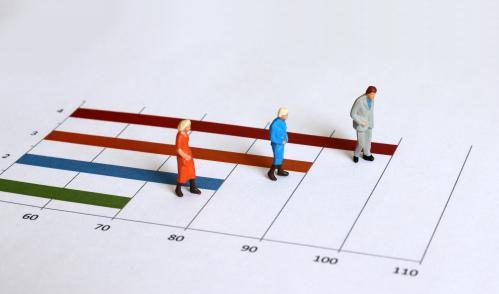In order to understand who benefits from student loan forgiveness, like that proposed by Senators Warren and Sanders, it is necessary to understand who owes the debt. The best data available to the public for this purpose is the Survey of Consumer Finances (SCF), because it provides a large sample of American households and captures information on their demographic, income, educational attainment, assets, and debts. Hence, it provides the data necessary to answer questions like “what share of student debt is owed by borrowers in the lowest-income 20 percent of households?” or “how would the cost and distribution of beneficiaries of debt relief policies change if the policy were limited to households with income or debt under some threshold?”
However, the SCF has limitations for looking at student debt For several reasons including but not limited to problems that plague surveys, like a tendency to under report certain elements of income or wealth, the total amount of student debt recorded in the SCF is about 25 percent lower than that reported in other sources, like the total balances reported by the Department of Education or the NY Fed’s Consumer Credit Panel.
This raises the question of whether analysis of debt forgiveness programs that use the SCF are inaccurate or, worse, biased. For instance, the SCF design excludes economically independent adults who are living in the same household as the primary survey respondent, such as roommates or adult children living at home. One practical concern is that parents might not include the debts of grown children “living in their basement” in their SCF response, with the implication that the benefits of debt forgiveness that would flow to low-income young adults living with their parents are not being recognized.
While working at the Department of Treasury, Constantine Yannelis and I calculated exact estimates of the income distribution of student loan borrowers using administrative data from the Department of Education matched to income and earnings data from tax records. While those data exclude private loans, they otherwise provide a comprehensive and accurate record of the debts, income, and earnings of Federal loan borrowers. These data do not have the shortcomings of the SCF. The analysis is summarized here and a more complete table is available here.
In our analysis, we calculated the distribution of student debt for income quintiles two ways. First, we ranked tax units by a measure of broad income (adjusted gross income excluding above-the-line adjustments) and asked what share of student debt was owed by individuals in each quintile (the middle panel of table 1). This analysis suggests that about 15 percent of student debt is owed by taxpayers in the bottom 20 percent of the distribution and 35 percent by borrowers in the top 20 percent. (See table and figure.)
Second, we used the earnings of student loan borrowers as reported on tax forms W2 or Schedule SE (including borrowers who had zero earnings) to rank them in the national earnings distribution in the 2013 Annual Social and Economic Supplement of the Current Population Survey (CPS) after adjusting for the age and gender of the population of student loan borrowers.
Specifically, we reweighted the CPS data to reflect the age and gender of borrowers following Dinardo, Fortin, and Lemieux (Econometrica 1996). In practical terms, this meant reducing the sample weights on older CPS households who are unlikely to have student debt and increasing the weights on younger borrowers. Intuitively, this analysis asks “if we rank all individuals with the same income and age distribution as student loan borrowers, where do student loan borrowers rank relative to their peers?”
Using this measure of income, 13 percent of student debt is owed by the bottom 20 percent and 36 by the top 20 percent.
A straight-forward comparison between the administrative data to the SCF suggests that the true distribution of debt shows a larger share owed by lower-income individuals but also a higher share owed by the highest-income taxpayers. Specifically, the SCF reports that 9 percent of total student loan debt is owed by the bottom 20 percent and 27 percent by the top 20 percent. The difference is largely that, in the SCF a larger share of the debt appears to be owed by middle-income borrowers (those between the 20th and 60th percentiles).
However, ranking tax units and individuals by income might not reflect economic wellbeing as well as ranking by the aggregate income of resource-sharing households, which makes the interpretation of differences between the SCF, tax units, and complicated. Two cohabiting adults sharing resources and splitting the rent are probably better off than if they live alone, and the student-loan borrower living in their parent’s home is probably better off than indicated by just the income on their own 1040. Some of the lowest-income individuals as ranked by tax income should probably be ranked higher in the income distribution. Likewise, some of the highest-income taxpayers are probably two-earner, joint filers; an adjustment for family size would likely rank some of them lower. Such adjustments would move the estimates from the administrative data closer to those from the SCF.
Nevertheless, the broader observation that most student debt is owed by higher-income households remains. Across the three sources and methods, student loan borrowers in the top 40 percent of SCF households owe 53 percent of all student debt; borrowers in the highest 40 percent of the earnings distribution owe 58 percent of student debt, and borrowers in the top 40 percent of the distribution of tax payers owe 59 percent.
Moreover, these figures do not account for the fact that we provide progressive repayment terms and a path to loan forgiveness for low- and middle-income borrowers that has reduced the monthly loan burdens for millions of borrowers and capped payments at 10 percent of discretionary income for almost all borrowers who ask for it. As a result of these income-based repayment plans, we have a federal loan program that is roughly self-sustaining, financed by the equivalent of a progressive income tax on those who have benefited from the program, offers eventual debt relief to low-income borrowers, and which requires no major legislative changes to lending programs, federal higher-ed spending programs, or speculative new taxes. There is no doubt our student loan system needs fixing, as I’ve argued before. For all these reasons, even if progressive lawmakers are successful in achieving these significant legislative changes, the net effect might not be as progressive as they hoped.







Commentary
Who owes the most student debt?
June 28, 2019